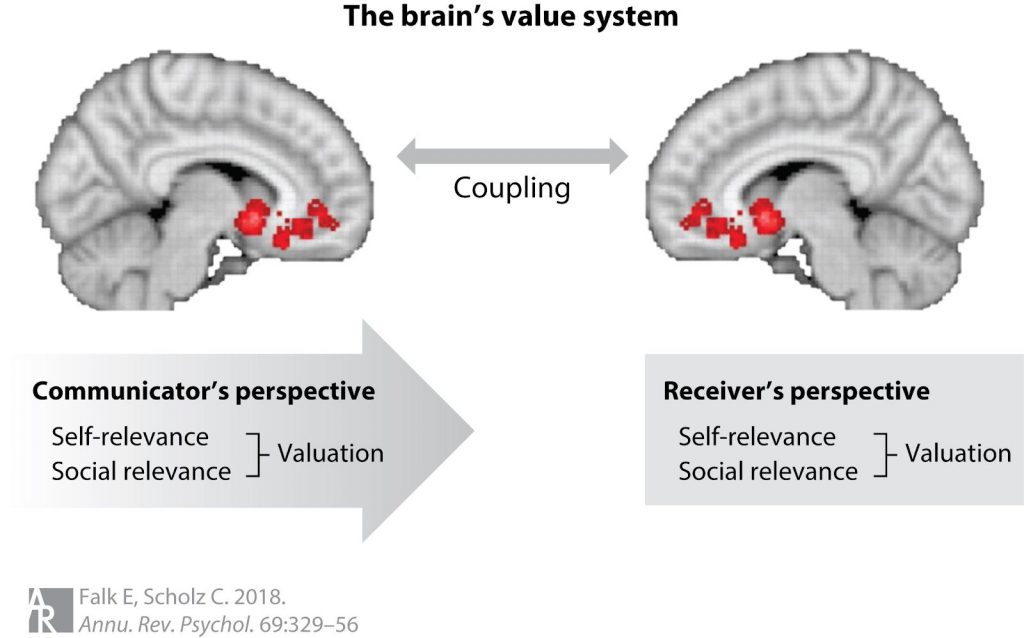Warren Center Affiliate Profile- Emily Falk
Warren Center Affiliate Profile- Emily Falk

Neural Responses to Social Networks
The leading causes of death both in the United States and throughout the developed world are modifiable health behaviors, such as poor diet, physical inactivity, and tobacco and alcohol consumption. These behaviors don’t happen in a vacuum– they spread from person to person and can be influenced by messaging interventions.
Given the high stakes and large numbers of behaviors that are socially influenced, Emily Falk, Associate Professor of Communication, Psychology, and Marketing, has focused her research on how different forms of social influence ranging from peer pressure to word of mouth and interpersonal sharing to mass media campaigns relate to behavior change in individuals, groups, and populations.
Emily’s research addresses basic cognitive, affective and social mechanisms driving behavior change, and how this understanding can improve communication-centered initiatives designed to influence behavior. Her findings integrate neuroscience with social network analysis to provide new insight about how people navigate the social world.
Collaborative Research
Emily’s lab in the Annenberg School for Communication takes an interdisciplinary approach to their research. Specific projects in the lab include predicting behavior change following exposure to persuasive messages, and understanding what makes successful ideas spread through social networks and through cultures. Currently, much of her research focuses on health communication and the design of better interventions, programs and policies. Recently, she’s also started working on questions about civic engagement and how to strengthen our democracy.
“I love getting to collaborate with people in different fields,” says Emily. “The most exciting projects my team has done have come from working with people in different areas like medicine, political science, computer science and bioengineering.”
Emily is currently collaborating with a number of Warren Center faculty affiliates, including projects with Dani Bassett (how brain network dynamics and social network dynamics interact with each other), Brett Hemenway (how we can use tools from machine learning to make better models to predict behavior from brain activity) and Chris Callison-Burch (what kinds of persuasive messages work best at scale).
How Information Spreads
Emily is particularly excited about her research on how information spreads between people, from brain to brain, and through social networks. This involves understanding how the social network structures that surround people influence how we use our brains, and vice versa. To further explore these themes, Emily’s lab uses tools from network science and social network analysis in their neuroscience investigations.

In this line of research, Emily examines how social-cognitive processes interact with broader social environmental variables like social status, and how social network characteristics interact with neural processes to predict the spread of ideas and behaviors. For example, her lab has shown that participants who have greater opportunities for information brokerage within their social networks show increased activity within the mentalizing system (neural activity in brain regions previously associated with considering the mental states of others) when making recommendation decisions, and when incorporating peer feedback into such decisions.
Although their current data cannot address the causal direction of the effects observed, it is possible that greater tendency to engage in mentalizing promotes more opportunities for information brokerage by improving individuals’ abilities to translate ideas across diverse groups. It is also possible that those who are exposed to more distinct groups of people in their social networks gain more practice mentalizing and then subsequently call upon those resources when asked to make recommendations to others.
Her data highlights value in using neural measures to study how and why ideas spread, uncovering mechanisms that would not be evident from self-reports or behavioral observation alone.
Emily’s Background
Emily became interested in understanding how people make decisions about their health during a Fulbright in Health Policy at the British Columbia Centre of Excellence for Women’s Health. A subsequent health care consulting job made her realize how hard it is to get people to change their behaviors. Integrating knowledge from her undergraduate degree in neuroscience, Emily wondered whether tools from neuroscience might help make it more efficient to design and select health messages.
“I was fortunate to have a fabulous graduate school adviser who was also excited about these questions,” says Emily, “and so we started exploring whether the brain could predict who would change their behavior and what kinds of persuasive communications would work best.”
Emily received her Psychology Ph.D. in 2010 from the University of California, Los Angeles and was previously an Assistant Professor at the University of Michigan before joining Annenberg’s faculty in 2013.
She has received millions of dollars in research funding, won numerous awards, and has published more than three dozen peer-reviewed articles in top journals across fields. Her team was recently awarded a grant through the prestigious Multidisciplinary University Research Initiative (MURI) in collaboration with Dani Bassett’s lab at Penn, Kevin Ochsner’s lab at Columbia and Peter Mucha’s lab at UNC to build a more comprehensive model of how social network and brain network dynamics interact to predict behavior change in the context of alcohol use in college students.